Text
Art 383 Journal 11: Nature
For this assignment, our class went outside with our sketchbooks and drew something related to nature. When we did this, the leaves on the trees were just beginning to change colors, so I decided to do a simple pencil rubbing and use it to experiment with colors. I found a large leaf and placed it under my paper as I rubbed a color pencil on the other side to capture the texture of the leaf. I kept the leaf under my paper as I experimented with different color combinations. My final drawing is very simple, but if I choose to, I can easily add other leaves to the drawing to add complexity.
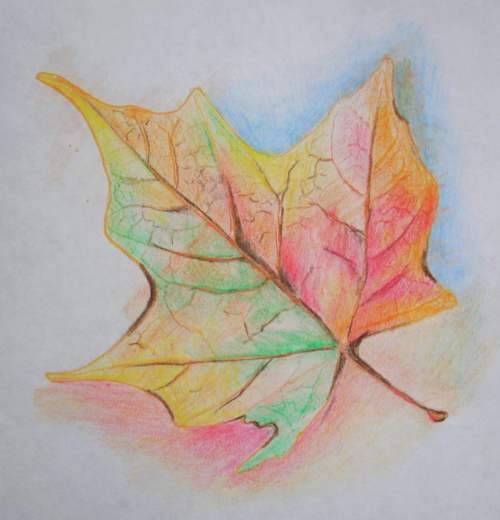
I thought this assignment was a lot of fun because the class got to go outside on a beautiful fall day. When I looked around at other people’s artwork, I was amazed at the diversity of drawings. One person glued crumpled leaves onto their page to make a tree while someone else sat in front of a tree trunk to draw the patterns found within the bark. This simple assignment is easy to put together, and young students would enjoy spending time outside.
5 notes
·
View notes
Text
Art 383 Journal 10: Photography Assignment
One project that I was not too happy about was a photography assignment. The class had several options for this assignment. We could either take pictures of landmarks that we see on the way to class, or we could make a photo collage of a town or city landmark. I chose to make a collage of a building on campus that looks like a castle.

When taking the pictures, I stood in one place as I moved my camera to different sections of building, and then later, I would combine the images to form one, larger picture. Printing my pictures was a challenge because I do not own a printer. I had to go to Walgreens and wait while they printed the images for me. Not only did it cost money, but it also took a lot of time to complete. I spent hours trying to match up the sections of the building and gluing them onto a poster board. In the end, however, I was impressed by how well the final collage turned out despite all of my previous frustration.
I will probably not use this project in a lesson plan. Although photography is an interesting form of art, the satisfaction that I received from the final product did not make up for the time and frustration that went into making it. To incorporate photography into a lesson, I would start with a smaller project that would take less time and serve as a basic intro to photography before assigning a larger project like this one.
0 notes
Text
Art 383 Journal 9: Visual Art as a Reflection of Music
One of my favorite class activities in Art 383 was when the class drew images or emotions that we felt as we listened to music. We heard three songs and drew one picture for each song. The first was “Moments in Love” by Art of Noise, and this is my oil pastel drawing that I made while listening:

Describing this piece is very difficult for me because some people may not relate to the images that I see. Certain types of sounds evoke specific colors and shapes in my mind. The song started out with very short notes that I associated with the color yellow, which I represented with yellow circles. I also heard a “chink” sound that I represented with green triangles. As the song developed, I envisioned a blue and purple wave merging pleasantly with the other sounds. Overall, the song was very relaxing and evoked positive emotions, so my artwork has mostly cool, blue hues.
The next song was titled “Violins of Violence” by Necro. The process for making this art was very similar to the first piece, except that the song evoked fear and tension instead of calmness. Because of this, I chose to draw on red construction paper. As I listened, I visualized dark spirals to correlate with the music.
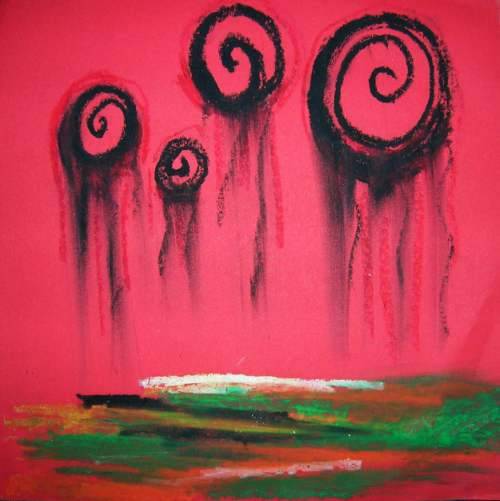
I do not know the name of the last song that we listened to, but it was a song composed only from train noises. I heard a train engine, maybe some shattering glass, and wheels across a track. The sounds from these various objects made the song very cluttered, which I depict in my artwork. The song did not evoke any powerful emotions, so I had a harder time drawing. However, I still enjoyed the exercise nevertheless.

I thought this was an excellent activity for an art lesson because it helped students focus on the unique sounds produced within a piece of music and reflect on their emotions. After class, I felt much more relaxed and focused than I did when I arrived at the beginning of class. The lesson was a lot of fun, and I would recommend this activity for all art educators to try.
3 notes
·
View notes
Text
Art 383 Journal 8: It's a bird... It's a plane... It's masculinity!
Yesterday in Art 383, we discussed the definition of masculinity. For some people, being masculine means having physical strength. For others, masculinity is the measure of a man’s sexual attraction of females. For me, masculinity means courage and compassion.
During class, each of us took a survey to help us refine our definitions of masculinity. The survey compared masculinity to the stereotypical image of a superhero. I’m embarrassed to admit that I am not familiar with many superheroes. I know of Superman, Batman, and Spiderman. Beyond these three characters, I’m clueless. However, one doesn’t have to be a comic book fanatic to recognize the male stereotypes portrayed in these superheroes. Superman, Batman, and Spiderman each have buff bodies and deep, passionate voices that only enhance their mysterious demeanor and flashy displays of altruism.
After completing the survey, we reflected on what it means to be a “true man” and drew pictures of a masculine superhero. This is what I drew:
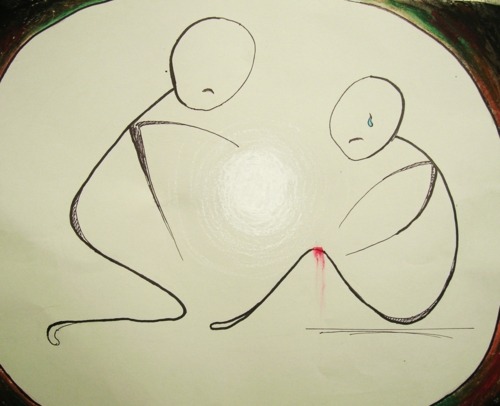
For this piece, I was frustrated that we were not allowed to draw a female, even though females can be masculine, too. So in retaliation, I drew gender-neutral figures. I intentionally omitted many of the figures’ facial expressions to draw the viewer’s attention to the action of helping another person. The greenish-brown border symbolizes the negativity often found in life, and the orb of white light in the center symbolizes the purity of compassion.
For me, “true men” are people who have the courage to help another person, even if that person’s problems seem minor or trivial. A true superhero does not need to have a muscular body; he needs to have a large heart. He does not need to be mysterious or have an alter ego; he needs to be a genuine, real-life role-model for others. He does not need a crowd of people to impress; he needs to show empathy towards each individual, even when no one is looking. Masculinity means having whole-hearted compassion towards every person and having the courage to do the right thing, even in the face of opposition.
#art 383#art 383 journal#art education#superhero#masculinity#compassion#superman#men#stereotypes#spiderman#batman
16 notes
·
View notes
Text
Art 383 Journal 7: Contrast
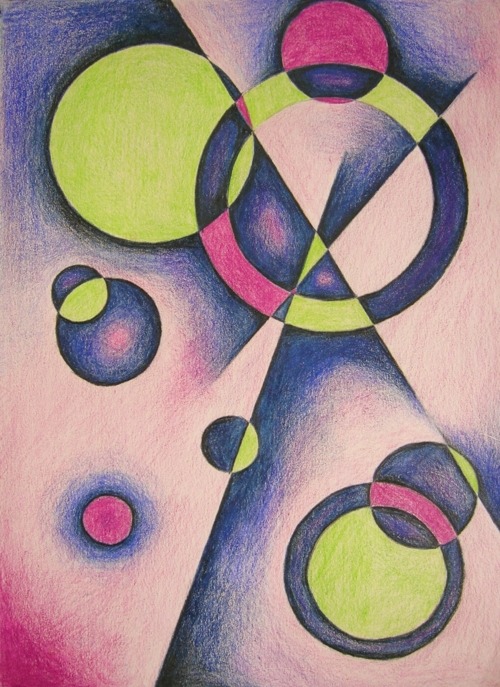
This is a drawing that I did for a contrast assignment. The class had to make an image that showed a clear distinction between light areas and dark areas. When creating contrast pieces, I’ve always found it helpful to squint at the picture. If I can clearly distinguish the content of the drawing when peering through my eyelashes, the piece has good contrast. If I cannot distinguish one object from another, the image does not have good contrast.
For this drawing, I used color pencils to create an abstraction of the solar system. I started by finding a variety of different circles to trace onto the page (let’s be honest, very few people can make a perfect circle on their own). I overlapped the circles to experiment with positive and negative space. These represent planets and moons. The lines represent rays of light from the Sun, which is the large circle in the upper-right corner of the page. Then I practiced making gradients with color pencils. To increase contrast, I used a black pencil to outline the darkest edges.
This would be a good project for middle school students. By middle school, most students already know the basics of using color pencils and how to combine colors. The project would challenge them to use gradients by experimenting with how hard they need to press with the pencils. It would also introduce them to contrast and positive and negative space.
26 notes
·
View notes
Text
Art 383 Journal 6: Repetition

For this assignment, we had to demonstrate repetition by using oil pastels. I am normally most comfortable using acrylic paints, so when I learned that we had to use oil pastels, I was a little nervous. Whenever I previously worked with oil pastels for a project, my pieces always turned out really messy, and I ended up throwing them away. However, after watching several oil pastel technique videos online, I soon became eager to give oil pastels another chance.
For this project, we had to draw one of the items on the table in front of us, in which I chose to draw aluminum foil. When looking closely at the aluminum foil, I noticed the repeating triangular wrinkles in the metal, which I exaggerated to make a repetition pattern. After experimenting with blending and different textures, I became intrigued by oil pastels. In fact, after class that day, I bought my own little box of pastels to try out at home. I thought this was a really fun class assignment. It brought me out of my comfort zone and encouraged me to try a new medium.
21 notes
·
View notes
Text
Art 383 Journal 5: Self-Portrait
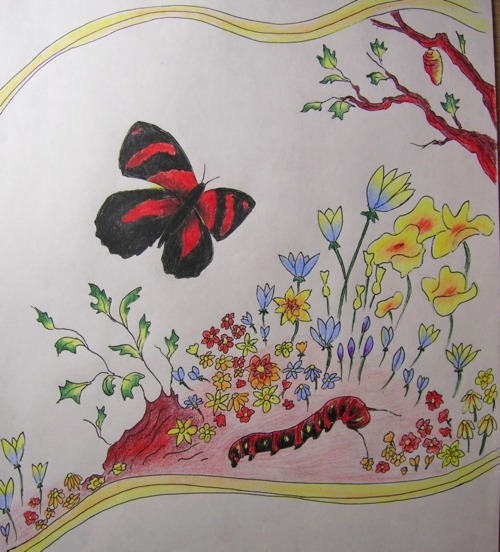
The second assignment for Art 383 was to create a self-portrait by drawing an object that represents us. I thought this was another excellent project for an art class because it encourages students to self-reflect on who they are inside rather than focusing on physical appearances. In a society that values individualism but is plagued by conformity, we have an obligation to ourselves to discover who we are and become what we want to be.
For my self-portrait, I chose to draw a preserved butterfly that I have inside a glass box. I liked the symbol of a butterfly’s self-metamorphosis. First a butterfly starts out as a caterpillar, then a cocoon, then finally a gorgeous butterfly. During this transformation, the caterpillar must struggle to survive, as represented by the red coloring throughout. The caterpillar must eat plenty of food and avoid predators to survive. After overcoming these challenges, the caterpillar reaches a higher stage of its existence in which it can take flight and express its beauty.
The butterfly’s metamorphosis is like my own. Just as a caterpillar must overcome many struggles, I must also overcome challenges in my life. For example, during these past five or six years, I have been reflecting on religion and the existence of a personal god. The subject of atheism is a delicate one because atheism directly challenges so many people’s worldviews. Likewise, other people’s strong religious beliefs sometimes challenge my views. My search for understanding and truth has been my greatest struggle, and as a result of this struggle, my life has been significantly altered. I may not believe in a god right now, but I have found the courage to explore different faiths, think critically, and discover what I believe even if it goes against many people’s beliefs.
As a caterpillar must fight to become a butterfly, I must fight to become who I want to be, so that someday, I will find the greatest purpose in life, be the best person that I can be, and reach my highest potential… a metamorphosis achieved.
10 notes
·
View notes
Text
Art 383 Journal 4: A Reflection on Cultures
I finally got around to taking pictures of my first project for ART 383. The assignment was to create a nametag for ourselves. The first side must have our name, and the other side must include the cultural groups that define who we are. During the first week of class, we discussed the definition of culture, which is the pattern of thought and behaviors that are characteristic of a society. There are many cultures that a person may belong to, and there can even be subgroups within those cultures. For example, I am American. However, the culture of Americans can further be divided into the cultures of each state. Not only am I an American, but I also a resident of Illinois. Even deeper than this, I am a student of NIU, which may be different from a student at another university. Culture does not end here. Culture can also include groups of people that share similar interests, food choices, religions, jobs, behavioral expectations, and lots more. Cultures can overlap, too. A person may belong to many different cultures, and each one shapes the thoughts and behaviors of that person.

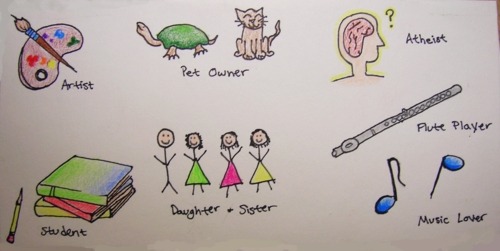
This nametag activity was a fantastic project to start the class off with for the first week. After learning about culture, we examined the cultures that influence us in our own lives. The interlocking web of cultures spans across many areas in my life, and this project has heightened my awareness of the people around me that make who I am. This project also makes me realize that culture affects everyone else, too, which helps me understand where people come from and why they think in a certain way. By learning about different cultures, students will open their minds to new ideas, have a greater appreciation of each other’s backgrounds, and find the common ground that connects us all.
8 notes
·
View notes
Video
Art 383 Journal 3: Power Teaching!
I came across this video over the weekend. This is a demonstration of whole-brain teaching, or power teaching, in a first grade classroom. When I first saw this, I was completely amazed at how responsive the children were to this method. Not only is whole-brain teaching a good way to establish a positive and interactive learning environment, but it also looks like a lot of fun! I specifically liked how the students had the opportunity to teach each other. I also liked the point system on the white board to reward good behavior. Each student was involved with the lesson and eager to learn. I would love to be able to establish this type of learning environment in the future.
#power teaching#whole brain teaching#first grade#math#art 383#lesson plan#art education#elementary education
10 notes
·
View notes
Text
Art 383 Journal 2: Remembering 9/11
For many of us, September 11, 2001 is a day we will never forget.
Ten years ago, the morning of 9/11 was a typical weekday morning, and I was in the fourth grade. I vividly remember my irritation at my dad as he turned on our small, kitchen television and shushed me into silence. I will be late for school! Can’t this wait? Then the T.V. caught my attention. A large building occupied the screen, and moody waves of smoke billowed upwards, staining the sky with its sickly darkness. However, it was not building on the T.V. that worried me; it was my dad’s expression. He clamped a hand over his mouth and sunk into a kitchen chair. His normally calm, blue eyes stared ahead with frightened shock. Over and over again, he muttered insanely to himself, “Oh, my God. Oh, my God…”
I did not understand at the time, but the U.S. had just experienced the worst terrorist attacks on American soil, and last week marked its 10th anniversary.
As a full-time college student, I was very busy that week. With tests to take, essays to write, and textbook readings to catch up on, I barely had more than a moment to reflect on this significant day, so when I arrived at Art 383 that week, I was grateful to have the opportunity to discuss 9/11. The class began with a discussion of our memories of the event. Like me, many people in the class did not understand the significance or reasons behind the 9/11 attacks, and some people even admitted to still not understanding it. As future teachers, we have an obligation to share the event with our students, and a great way to accomplish that is through art.
The project in class that day was to create a class tapestry to depict the events of 9/11. The teacher provided us with a long sheet of paper that was divided into three sections. For the first section, we drew symbols to represent the U.S. On the second section, we illustrated the before, during, and after parts of the attacks. On the third section, we drew out the world’s reaction to it. I thought this was an excellent way to remember this day. Not only did the project encourage the class to work together, but it also helped us to exchange ideas to increase our understanding and appreciation for September 11th. This was a very appropriate and fulfilling project to do for that week, and I will definitely remember this project for future lesson plans.

1 note
·
View note
Text
Art 383 Journal 1: Finding Beauty
It was 7:51 a.m. on a cold January workday when a young white man entered a Washington D.C. Metra station. He wore simple jeans, a T-shirt, and a baseball cap and carried a violin case. After settling himself next to a wall, he carefully took out his violin, left the case open at his feet, and began to play.
During the next 45 minutes, he played 6 Bach pieces while over 1,090 people hurried by on their way to work. Of those 1,090 people, only 6 stopped to listen, and 20 gave him money while continuing on their way. He made $32.
People did not know that the violinist was Joshua Bell, one of the most talented musicians in the world. He played on a 3.5 million dollar violin, and just that week, his concert sold out at $100 per seat. This 2007 social experiment was set up by the Washington Post to determine how many people would stop to appreciate music in the middle of a common setting. The results were dismal. (You can find the complete experiment here).
When considering American culture today, I immediately recalled this experiment. Art is all around us, including anything from Joshua Bell’s complex melodies to a simple sunset, but so many Americans fail to recognize it. Art is slowly fading from our culture, being replaced by technology. We have cell phones, computers, mp3 players, televisions, and videogames. We have texting and social networking websites. Our lives get faster and faster with each technological milestone; everything we need is at our fingertips.
Unfortunately, too many of us become so absorbed in our own lives that we forget to look outwards at the beauty around us, to appreciate things in life that we take for granted.
This week in Art 383, each of us researched two multicultural artists to share with the class. More projects like this should be included in elementary school curriculum because it gives students the opportunity to observe art forms that they normally wouldn’t spare a second glance for. For example, I researched Ando Hiroshige (1797-1858), a Chinese artist who created delicate woodblock prints using carefully planned gradients and lines. I’ve never considered how much patience and technique is required to make just one piece. His work later influenced the art of Monet, Van Gogh, and Whistler.
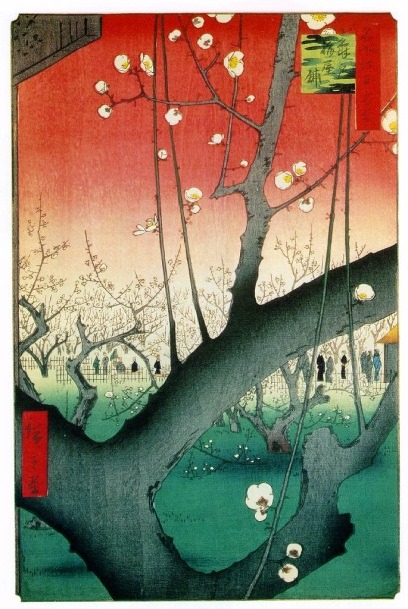
"Plum Estate" by Hiroshige
I also researched the artwork of Emily Carr (1871-1945), whose fascination with indigenous peoples and deep woods inspired many of her paintings. Unlike Hiroshige, Carr often used strong, expressive brushstrokes to capture the power of the trees, sky, and wind.
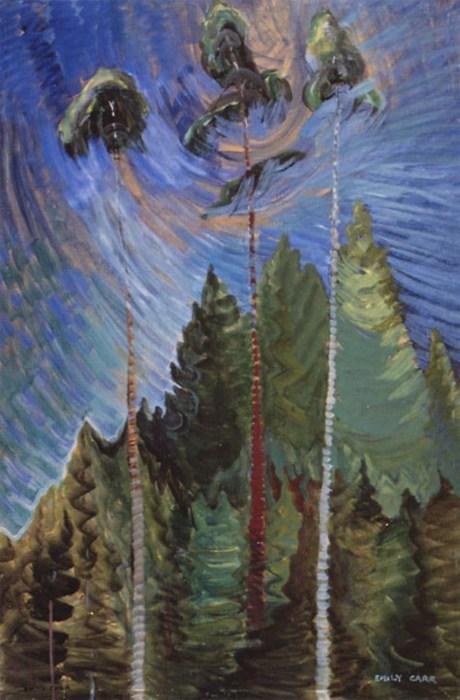
"Odds and Ends" by Carr
Researching these artists has helped me look outside of my own life and find appreciation for art. Beauty can be found anywhere, in any form. Whether we find it echoing around a Metra station, painted onto a canvas on a wall, or sending rays of color across a horizon at nightfall, beauty can be found… if only we look.
0 notes